Monday, January 30, 2012
Hakka Yong Tau Foo (客家釀豆腐)
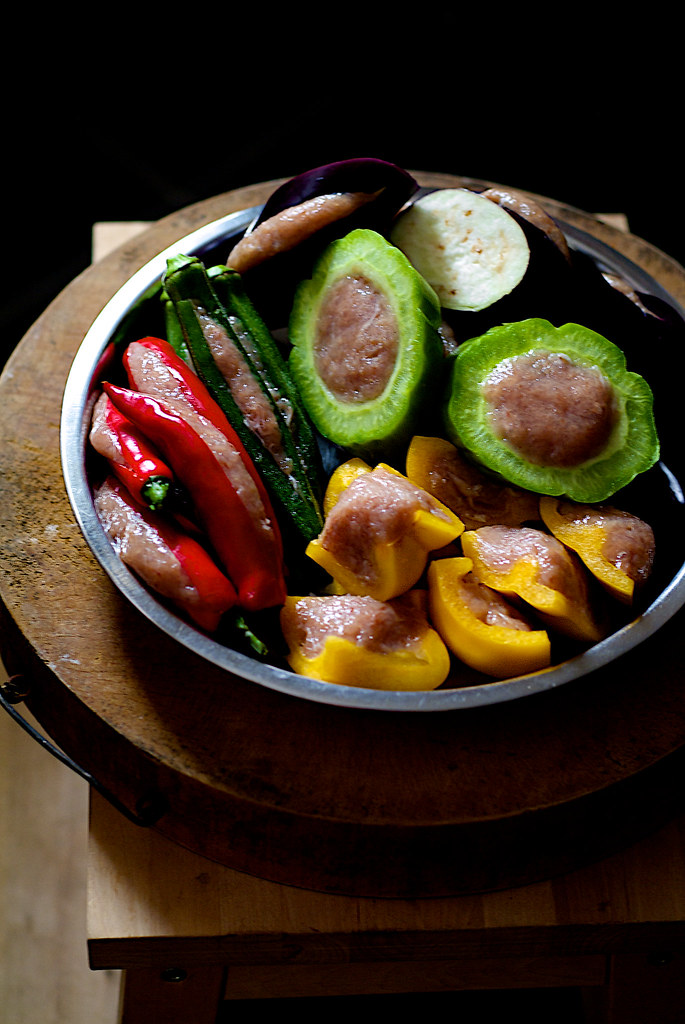
It's the eighth day into the Dragon year and I must admit I've enjoyed last week's indolent moments rather immensely. Most of my time in Kuala Lumpur was spent at home,
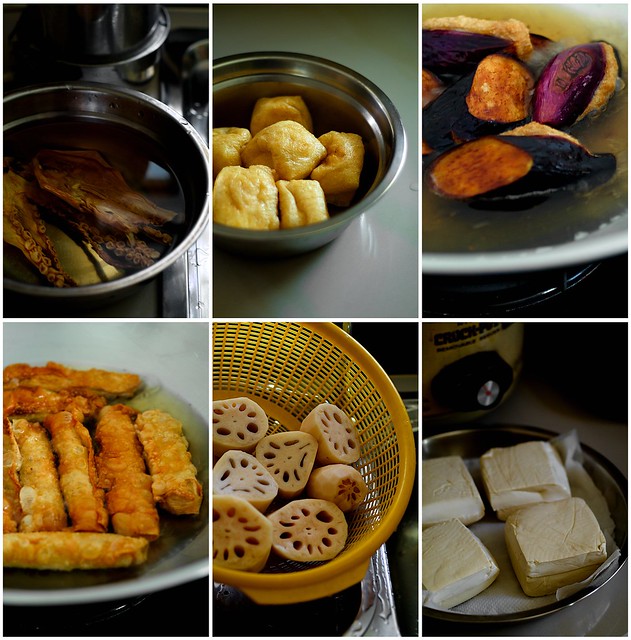
It wasn't all play and no work though. This New Year, I told my mother we would cook. We're a small family, so there was really no need to storm up four dishes and one soup (四菜一汤, a Chinese saying to reflect a nourishing, complete meal). However, eating out for the pass three reunion dinners proved to be quite tiresome (there's only so many years one can be excited over steamed fish, abalone mushroom and other standard New Year restaurant-what-have-yous) not to mention how excessively damaging it is on the wallet. When my late father was still around, we used to eat at home even during the festive season, so I decided on Hakka Yong Tau Foo (客家釀豆腐) and lotus root soup for our dinner on the final night of the Rabbit year.
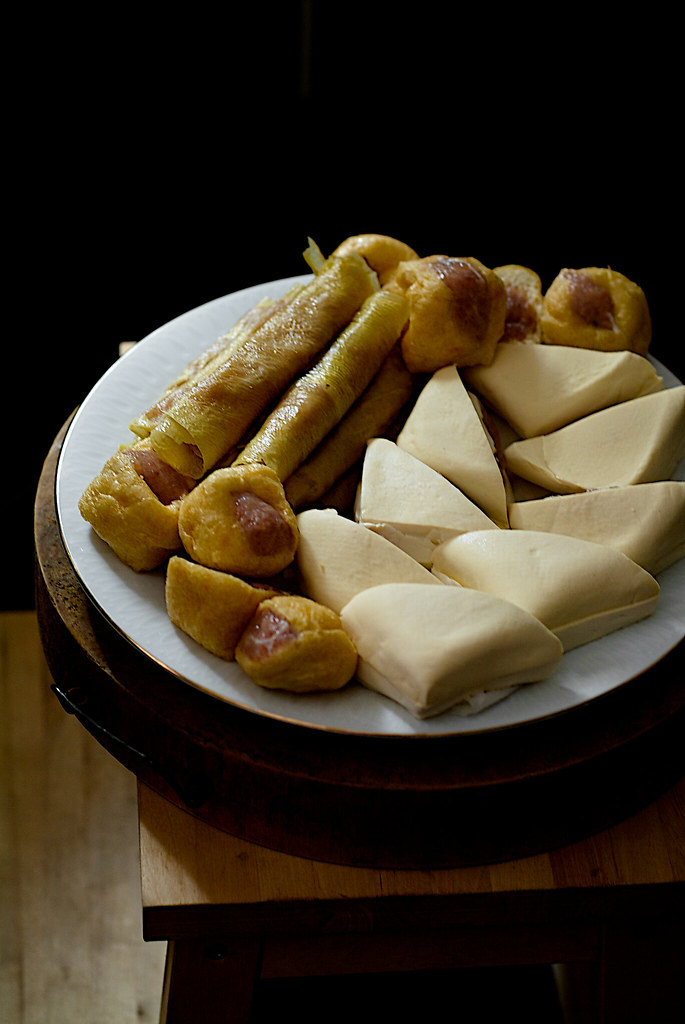
I had an agenda, obviously. Having made the Hakka Tofu Sung (Salted Fish Tofu with Minced Meat, 客家豆腐鬆) here in Singapore using readymade fish paste, I wasn't happy with the commercial grade fish paste available. It is easier to get better ones from fish mongers in Kuala Lumpur, but if I'm to ace a good Yong Tau Foo in my own kitchen, I would have to make my own fish paste and obtain the tricks from Mum. In return for the master class, she asked for my Chinese chicken rice for dinner on the eve of the Eve.
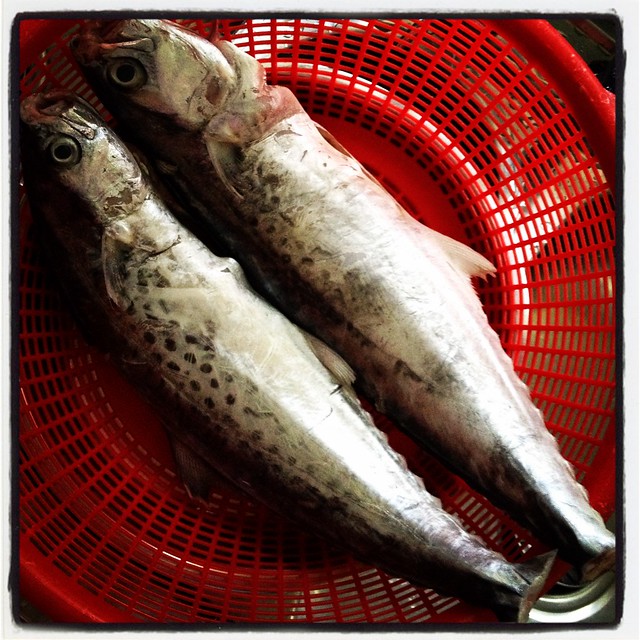
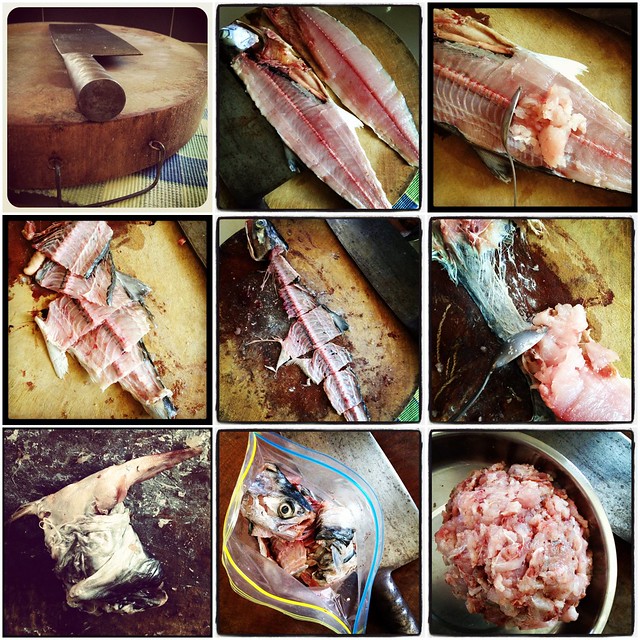
Hakka Yong Tau Foo is essentially stuffed tofu. The Hakka people love their pork and salted fish and traditional Hakka dishes would be based around these two ingredients. The Yong (stuffed) Tau Foo (tofu) is of no exception, made from fresh semi-firm tofu stuffed with a pork-fish meat paste flavored with salted fish, then either fried or stewed, served with a fermented bean paste (tauchu) sauce spiked with chili. My parents had taken to making the dish without the pork and salted fish in the name of simplicity, though my late grandfather had always prepared it the Hakka method.
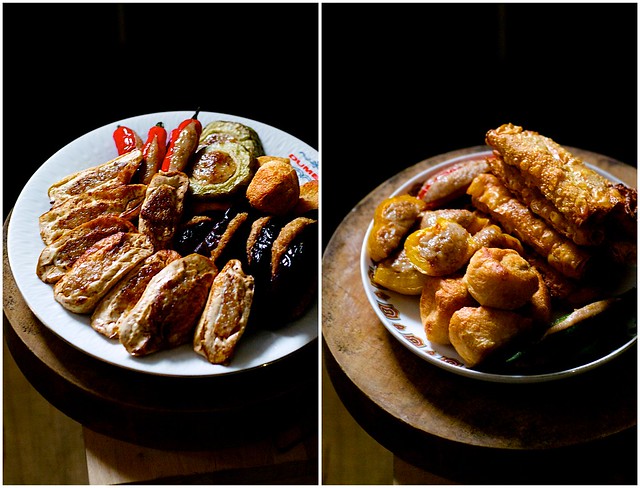
Since I grew up with homemade Yong Tau Foo, most of the time stuffed with fish paste from scratch, I hardly order it when eating out. It's difficult to make do with mediocre commercial grade stuffing, often watered down, laced with (unnecessary) corn starch (I'll get to that) and at times not even minced from fresh fish (fishy smelling Yong Tau Foo stall is a hint). There's not much space in my heart for the clear (and mostly bland) broth noodle, curry, sweet dark sauce and chili dip that came into play with the evolved versions of Yong Tau Foo. Even shops claiming to serve authentic Hakka Yong Tau Foo seem to miss the point - the spicy tauchu sauce.

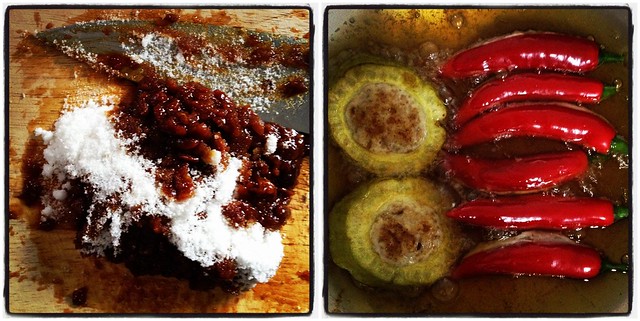
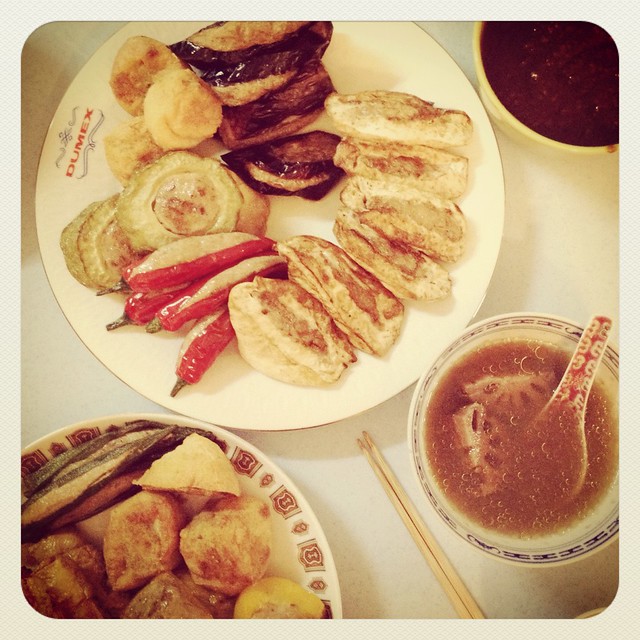
So after coming across to you as a Yong Tau Foo snob, let me clarify that kick-ass sauce aside, it's really about the fish. Fresh, sea Spanish mackerel fish meat is naturally sticky when minced so there's no need to add any flour or starch as binder. Use just enough salted water to smooth out the paste, give it a few hard knocks against your largest chopping board and you're all set. Check your fridge crisper for leftover vegetables - a perfect way to use up those stray red chilies and that lone bell pepper. You can also stuff fresh or soaked dry shiitake mushrooms. As I was fiddling with pieces of slippery, jelly-like tofu, trying very hard not to break them with too much fish paste, Mum quietly confessed that she never stuffed the actual fresh tofu before. She did all the other things, bean curd skin (foo pei), deep fried tofu balls (tau foo pok), fried tofu (taukwa) and vegetables. Apparently, she was too afraid to handle stuffing fresh tofu. Also, she added defensively, even late Dad never did it using fresh tofu. "Why stress yourself out with the finicky tofu?", Mum asked.
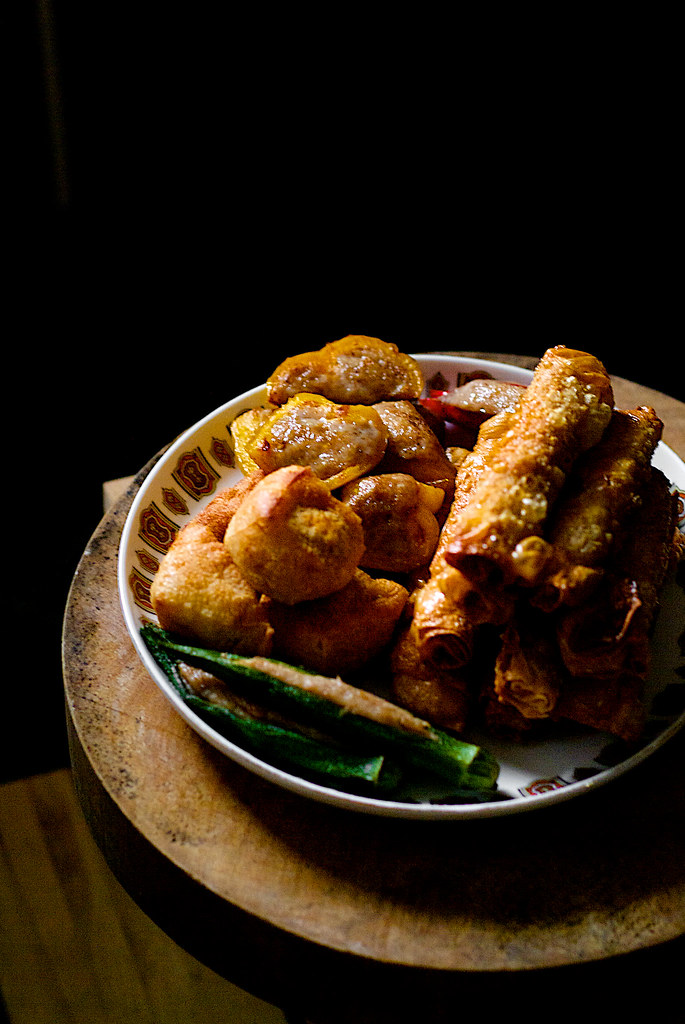
Therefore, this Chinese New Year saw yours truly as the first fresh tofu stuffer in this Hakka family. I assure you it wasn't that bad. One broken tofu stiffened up and stayed in one piece after being fried. I was quite proud of my handiwork and even Vijay was impressed. If you are a fan of Yong Tau Foo, give the homemade fish paste a go because really, there's nothing like the real deal.
Hakka Yong Tau Foo (客家釀豆腐) [Printer Friendly Version]
Recipe from my mother.
Serves 6-8
Notes: Traditionally Hakka Yong Tau Foo stuffing is made with fish, pork and salted fish. You may use 500 grams of fish paste and 500 grams of pork mince plus 30 grams of good quality mui heong (梅香, soft, slowly aged threadfin) salted fish to go that route. Vegetable trimmings such as finely chopped scallions, carrot and chilies are sometimes added to the paste for color. Adjust the frying time when mixing with pork (roughly an extra 2 minutes for each round), as meat cooks slower than just fish.
If dealing with a whole fish is not your thing and you'd rather use readymade fish paste, either get it fresh from your fishmonger or look for packaged ones with the least amount of additives/preservatives/liquid. Any leftover fish paste can be reserved to make fish balls or fish cakes for soups, congee or vegetable stir fries. The tauchu:sugar ratio in the dipping sauce is always 1:1, so you may adjust the recipe accordingly (this recipe yields about 3 cups).
Fish Paste:
- 2 medium, fresh Spanish mackerel (about 600 grams each), clean and drain well
- 1 - 1/2 heaped teaspoon salt
- 1/4 cup water
- freshly ground white pepper
- 4 pieces square semi-firm tofu, drain well, half diagonally, make a small slit on the cut side
- 6 pieces tau foo pok (deep fried tofu balls), half diagonally, make a small slit on the cut side
- 4 pieces bean curd skin sheets, dampen with a wet cloth, cut into half (about 4x6-inch rectangles), trim uneven edges, reserve trimmings
- 1 medium long eggplant, slice at an angle, slice horizontally almost to the edge
- 1 small bitter gourd, remove seeds and slice at an angle
- 1 yellow bell pepper (I used yellow due to the color scheme) , remove seeds, cut into 8 pieces
- 6 fresh red chilies, remove seeds, slit lengthwise
- 4 ladies finger/okra, remove some seeds, slit lengthwise
- a small bowl of salted water
- 1 beaten egg (to seal rolled stuffed bean curd skin)
- about 2 cups peanut or vegetable oil for deep frying
Tauchu Sauce:
- 3 tablespoons tauchu (Chinese fermented soy bean, if unavailable, Japanese miso or Korean Doenjang are good substitutes)
- 3 tablespoons sugar
- 5 cloves garlic, minced finely
- 5 shallots, minced finely
- 2 centimeters ginger, minced finely
- 5 tablespoons hot chili sauce (use Sriracha sauce, sambal paste or add freshly chopped birds eye chili for more heat)
- juice and zest of 1 lime
- a few sprigs of fresh coriander, finely chopped
Prepare the fish paste: On a large chopping board, fillet the fish from tail to head on one side, avoiding the dorsal and ventral frame, but taking off the gill bone/operculum (just below the head) along with the fillet, leaving the head intact (refer to fishy photos above). Set the fillet aside. With a small spoon, scrape the fish meat off the bone from head to tail. Repeat the filleting and scraping with the other side. Place the fish skeleton aside. Repeat scraping the fish meat off the fillets, holding on to the fin bone, not tearing the skin. Repeat with the other fish. Reserve fish skeletons and trimmings in a freezer bag for stews, stocks or congee.
Clean the chopping board and dampen slightly with a splash of water. In a small cup or bowl, mix the salt with the water well. With a cleaver or a large knife, chop up the gathered fish meat into a rough mince. (Fresh sea mackerel meat is naturally sticky; you will need to scrape off the cleaver/knife constantly from this point.) Add about 1/3 of the salt water and a dash of pepper to the mince; continue chopping to mix in the seasoning. Repeat the seasoning and chopping twice until all salt water is used up.
Divide paste into two balls. Set one ball to the edge of the chopping board. Lift the other one up at least about 1 1/2 feet away from the board and throw it onto the center of the board with force. (Caveat: Aim well.) Gather it back and repeat this (rather fun) bit about 10 times. (Avoid overdoing this, although it's a good way to reduce some pent up anger (if any), as it will result in a tough instead of springy fish paste.) Repeat with the other half of the mince. Slap the two halves of mince against each other and gather into one slab. At this point, you can divide the paste into portions if not using all of it immediately. Wet hands, smooth out the paste all around with some water and store in a freezer-safe container. Fish paste keeps up to 3 months in the freezer.
Prepare the stuffed items: If fish paste is chilled, bring it to room temperature. Meanwhile, prepare the tofu and other items for stuffing. Set aside a small bowl of salted water. Use
a small butter knife to stuff the tofu (be extra gentle with this one), fried tofu balls and vegetables. The amount of paste to use varies, generally chilies, ladies finger and bitter gourd use up more filling. Clean up the edges and smooth out the fish paste with some salted water. (Avoid overstuffing the tofu and vegetables as they may tear/break during frying.) For the bean curd skins, spread a thin layer of fish paste on each sheet (short side facing you), add on some of the trimmings, then roll the sheet up and away. Seal the edges with a little bit of beaten egg. Lay out all the stuffed items on a platter/tray to prepare for frying.
Prepare the dipping sauce: If using whole bean tauchu (whole bean, not paste, is of better quality), finely chop up the beans together with the sugar. In a medium bowl, mix well all the sauce ingredients except the coriander. Set aside.
Cook the stuff items and sauce: In a large wok or a heavy bottomed saucepan, heat up oil over medium heat and fry the stuffed items by batches, starting with the vegetables and ending with the fresh tofu. Lay the stuffing side down to cook the fish paste, then flip over and around to cook the vegetable/tofu, about 4-5 minutes each side. Tips: Ensure oil is hot enough for deep frying to avoid oil-clogged results. The tau foo pok is already cooked, this will take the shortest time. Avoid frying the chilies and ladies finger for too long, they will shrink and separate from the filling. Tofu is fried last due to the moisture; eggplants take the longest to cook.
Drain the fried items on kitchen towels before transferring them to the serving platter. Reduce the oil in the wok to about 2 tablespoons. Pour in the mixed sauce ingredients and fry for about 4 minutes over medium heat till thickened slightly. Check and adjust seasoning. Turn off heat, add in the coriander. Dish out into a bowl and serve the Yong Tau Foo with warm rice if desired.
Life Is Great explores the incredible world of food and cooking. We hope to share with you our most delicious moments and inspirations.
“Just like becoming an expert in wine–you learn by drinking it, the best you can afford–you learn about great food by finding the best there is, whether simply or luxurious. The you savor it, analyze it, and discuss it with your companions, and you compare it with other experiences.”
Julia Child (Mastering the Art of French Cooking)
“Life is short. Live your dream and share your passion.”
- Gooey Cinnamon Cake
- Chinese Crispy Roast Pork Belly (Siu Yuk 烧肉)
- ABC Soup (罗宋汤)
- Kong Bak Pau (扣肉包)
- Pandan Chiffon Cake (Improved)
- Crispy Fried Egg
- Tamago Kake Gohan (卵かけご飯)
- Strawberry Pie
- One Pot Chicken Rice
- Bak Chor Mee (肉脞面 - Minced Pork Noodle)
- Hakka Salted Egg Steamed Pork (咸蛋蒸猪肉)
- Hong Kong Part III
- Hong Kong Part II: Zongzi/Bakchang (粽子/肉粽)
- Caffè HABITŪ (the table) at G.O.D. Causeway Bay, Hong Kong
- Hong Kong Part I
- Australia 2010 Part 1: Melbourne
- Bourke Street Bakery, Sydney
- Il Fornaio, St Kilda
- Queen Victoria Market, Melbourne




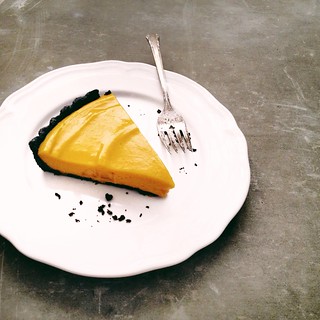

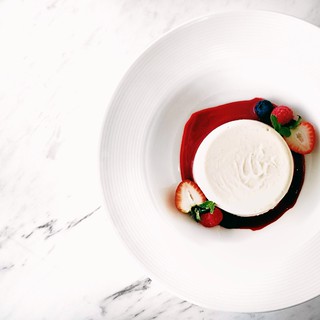
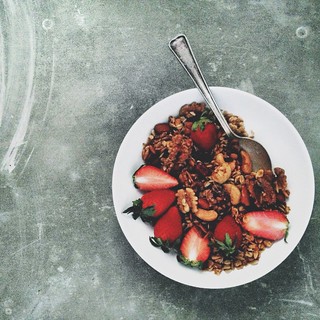
11 Comments on Hakka Yong Tau Foo (客家釀豆腐)
Reading your blog is always such an education! The amount of incredible knowledge and preparation that goes into this dish is amazing. I'd love to be able to cook these kinds of dishes so am bookmarking for when I feel brave!
Posted by thelittleloaf, at
Feb 1, 2012, 9:59:00 AM
thelittleloaf, at
Feb 1, 2012, 9:59:00 AM
I have some Hakka blood and that part of me certainly loves her pork and salt fish! I'm also interesting in the culinary traditions of the Hakka, so this was a very good read. Wonderful blog you have here.
Posted by Jane @ The Wayward Oven, at
Feb 1, 2012, 10:05:00 AM
Jane @ The Wayward Oven, at
Feb 1, 2012, 10:05:00 AM
thelittleloaf: Thank you! Traditional recipes are always intriguing to me, regardless of where they originate from. No bravery required for this dish, just a little bit of patience and a few hours of your time.
Jane: I love salted fish too but my parents tried to limit our intake as it's not the healthiest food to consume too frequently. Thank you for your kind feedback!
Posted by PickYin, at
Feb 1, 2012, 10:07:00 AM
PickYin, at
Feb 1, 2012, 10:07:00 AM
Love this recipe! Thanks for sharing. I love Hakka yong tau foo.
Posted by penny aka jeroxie, at
Feb 1, 2012, 10:36:00 AM
penny aka jeroxie, at
Feb 1, 2012, 10:36:00 AM
so funny la u and ur mom. yong tau foo exchanged with chicken rice.. and yes, this year we decided to have the reunion dinner with relatives in our new abode, which seems much more fun and flexibility compared to standard New year restaurant menus..
Posted by Swee San @ TheSweetSpot, at
Feb 1, 2012, 12:15:00 PM
Swee San @ TheSweetSpot, at
Feb 1, 2012, 12:15:00 PM
penny: Thanks! Hope you'll try it when you miss home.
Swee San: Yes, my mother is good at asking for a meal from me. The last time she came to SG she wanted nasi briyani. Next year I'll try to do homemade Yee Sang like you!
Posted by PickYin, at
Feb 1, 2012, 3:07:00 PM
PickYin, at
Feb 1, 2012, 3:07:00 PM
I have a good friend who would not eat Yong Tau Foo outside because she claims that her mum makes the best. I will have to learn from the aunty.. and I love Yong Tau Foo!
Posted by Shirley @ Kokken69, at
Feb 6, 2012, 10:36:00 PM
Shirley @ Kokken69, at
Feb 6, 2012, 10:36:00 PM
Shirley: Your friend is like me, although when push comes to shove and I deem there's nothing else better to eat, I would order it outside. It's not hard to make, considering some of the other things we whip up in the kitchen.
Posted by PickYin, at
Feb 7, 2012, 9:38:00 AM
PickYin, at
Feb 7, 2012, 9:38:00 AM
Dropping by to say, Thank you for sharing!
Posted by z, at
Feb 9, 2012, 1:45:00 AM
z, at
Feb 9, 2012, 1:45:00 AM
Andrias: You're welcome. Thanks for dropping by!
Posted by PickYin, at
Feb 10, 2012, 11:16:00 AM
PickYin, at
Feb 10, 2012, 11:16:00 AM
gasp! dumex plate!
Posted by What A Lulu, at
May 27, 2012, 1:14:00 AM
What A Lulu, at
May 27, 2012, 1:14:00 AM
Post a Comment